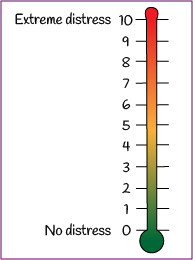Screening is a brief, repeatable means of assessing the presence of psychological distress. Use of a screening tool with all patients can be helpful in identifying low mood/depression and anxiety. It is also helpful in putting mood and wellbeing on the agenda, indicating that “this is something that we are interested in and happy to talk to you about. This is normal. It is part of our job”. The screening tool opens up the potential for a conversation where people feel that they can discuss this again, at any time. “You mentioned last time that you were feeling a bit low. How are you feeling this week/now? Would you like to complete the screening tool again?”

A number of assessment and screening tools have been validated and are generally available. The benefit of using an objective screening tool, such as the Distress Thermometer or the Hospital Anxiety and Depression Score (HADS), is because the use of such a tool offers a brief and pragmatic method of identifying patients with psychosocial distress, with the goal of determining who needs referral for more extensive assessment. It is a triage process, to be used in conjunction with your own impressions after speaking to the patient.
Use of a screening tool or standardised questions with all patients at every patient contact greatly increases the chances of identifying low mood/depression and/or anxiety.
Pulse point
A number of different screening tools are available:
- File: Distress thermometer [PDF, 268KB]
- Patient Health Questionnaire (PHQ-4)
- Generalised Anxiety Disorder Questionnaire (GAD-7)
- Patient Health Questionnaire (PHQ-9)
- Hospital Anxiety and Depression Scale (HADS) (Available at licensed NHS Health Boards.)
Page last reviewed: 31 Jul 2020


